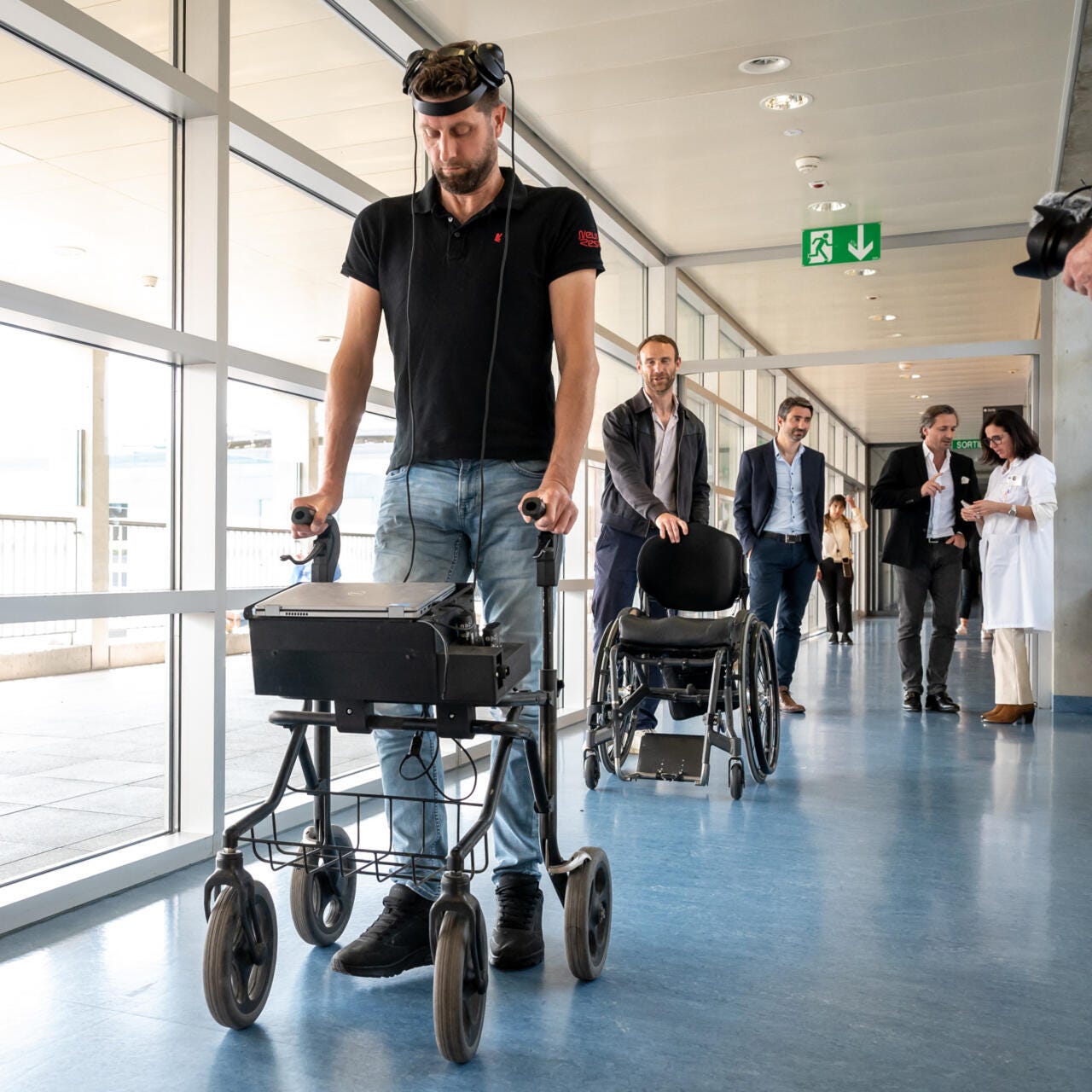The Dawn of AI-Enabled Accessibility
Fundamental improvements to assisted-living services will mark the dawn of a world where most physical limitations no longer define human agency, and where autonomy is increasingly a matter of engineering, not fate. With AI-powered assistive technology, visual impairments, hearing loss, and paralysis will soon be barriers of the past.
Historically, physical impairments were destiny. They impeded someone’s ability to live independently and contribute to society. Only recently have we approached the technological thresholds capable of overcoming these barriers, driven by rapid innovation. With these advancements, the idea that individuals with disabilities could or should experience full autonomy has emerged. For example, the Americans with Disabilities Act of 1990, which guarantees equal access, wouldn’t have been possible even a few decades prior. Breakthroughs in battery life, cost, and miniaturization have made motorized wheelchairs accessible, and now, ramp access is a practical legislative goal.
As technology continues to advance, AI will significantly reduce permanent lack of autonomy, and grant agency to those who previously operated without it. This is increasingly important as our population ages and reliance on assistive technologies grows. As the market expands and our comfort level grows, AI-powered assistive technology may even lead to a broader human-AI symbiosis, pushing the boundaries of our current societal thresholds.

AI is Already Revolutionizing Assistive Tech
Undoubtedly, AI is improving medical outcomes and achieving feats once deemed impossible. Particularly exciting developments have emerged in restoring paraplegic movement, enhancing hearing and speech, and improving the lives of the visually impaired.
Thought-Controlled Robotics: Restoring Agency
At the forefront of this assistive technology are Brain-Computer Interfaces (BCI), enabling paralyzed individuals to regain autonomy by controlling devices and regaining limb movement.

Neuralink is one example of a BCI pioneer that uses a chip with “1,024 electrodes distributed across 64 threads, each thinner than a human hair” implanted onto a patient’s brain.1 After receiving the chip, their first patient, Nolan, an eight-year quadriplegic, was able to control a computer using only his brain. Since then, two more patients have had successful Neuralink implantations.2
Yet another team has used BCI technology from a Dutch Company called Onward to restore a 56-year old man named Gert-Jan Oskam’s ability to walk. Connecting implants on his brain and abdomen, AI reads his intentions and stimulates muscles allowing him to walk, while bypassing his spinal cord nerves.3

While BCI still poses technological challenges and raises ethical concerns, the key result is the same: it is restoring autonomy in previously impossible cases.
AI-Enhanced Hearing and Speech: Breaking the Barriers of Silence
Another key innovation area is AI-powered hearing aids and speech recognition tools, which empower those who are hard of hearing and with speech impediments to regain full participation in society. These tools filter noise, enhance speech recognition, and adapt to environments in real-time.
For those who are hard of hearing, advances in cochlear implants are groundbreaking. These devices, in contrast to traditional hearing aids which just amplify sound, bypass damaged portions of the ear to directly stimulate the auditory nerve. AI tools are improving sound isolation in these devices, helping users focus their attention by distinguishing a speaker’s voice from background noise.4

Other tools like AI-driven lip-reading software further augment communication. Automatic speech recognition programs can convert audio into captions, using machine learning to provide context and determine what is being said. AI models now outperform professional lip readers, for in-person and phone conversations.5 Rochester Institute of Technology has already implemented these features in their classrooms, transcribing lectures in real-time.6
Other companies are working to expand this into sign language translation and speech generation, while teams like Google’s Project Euphonia are aggregating databases of distinct, atypical speech patterns and training AI models to better recognize these sound waves.7 These projects are restoring speech to those without it, leaving users more capable of participating in society.
AI for the Visually Impaired: Seeing Beyond Sight
For the blind community, AI can not restore sight, but it can transform the world into a place where blindness no longer means disconnection from visual information. Teams from Seeing AI and Envision are helping develop models that narrate the world for blind individuals. With machine learning, we are improving real-time object recognition, facial identification, and text-to-speech conversion.
This means a complete shift in autonomy. One user recalls:
“I was born totally blind, and my visual world has always been determined by what well-meaning people can tell me…Suddenly, I was in a world where nothing was off limits. By simply waving my cellphone, I could hear, with great detail, what my friends were wearing, read street signs and shop prices, analyze a room without having entered it, and indulge in detailed descriptions of the food—one of my great passions—that I was about to eat.” – Milagros Costabel8
Through AI-powered technology, people are regaining self-sufficiency in all senses: mobility, hearing, speech, and vision.
Assistive Technologies Could Lead to Human-AI Symbiosis
As the transformative power of AI-based assistive technology becomes more integrated into society, broader human-AI symbiosis becomes plausible. Currently, there is fierce societal opposition to this idea. According to a PEW poll, “52% of Americans say they feel more concerned than excited about the increased use of artificial intelligence. Just 10% say they are more excited than concerned, while 36% say they feel an equal mix of these emotions.”9
But as our comfort level grows through exposure, broader human-AI symbiosis could fundamentally enhance human capabilities, shifting AI from a tool to an extension of human will. A personalized AI-powered device constantly monitoring your health metrics would drastically improve longevity and quality of life. Personalized AI-powered cognitive supplements would make us smarter and more productive.
Considered in isolation, these tools seem futuristic but considered as the next iteration of assistive technology, the ideas become plausible.
The Case for Preserving Our Human Environment
Under the assumption that human-AI symbiosis is soon achievable, there are still risks associated with these assistive technology advancements. For one, there is a growing risk that we become overly dependent on technology. For some, living in a virtual world that is not bound by physical limitations could become more appealing than living in the physical world. This should not be our goal. Instead, we need to focus on preserving meaningful human interaction, using AI to augment real life, rather than replace it.
Increased access to the physical world does not reduce the importance of it. The key is to leverage AI and assistive technology to enhance human agency, not replace human experience.
The impact of this technology on society is profound. AI-enabled accessibility overcomes physical limitations and expands the possibilities of human experience. As we continue to develop and refine these innovations, we must ensure they remain tools of empowerment, preserving human connection while unlocking new levels of autonomy.
Share Your Thoughts With Us!
Thank you for imagining The Next Renaissance with us.
We’d love to hear your thoughts. What excites or concerns you about AI’s role in expanding human potential? Leave a comment or question below, and we’ll do our best to respond directly or write about the topic in an upcoming post.
Chappell, B. (2024, January 30). Elon Musk's Neuralink has put in its first human brain implant. NPR. npr.org/2024/01/30/1227850900/elon-musk-neuralink-implant-clinical-trial
Kleeman, J. (2025, February 8). Elon Musk put a chip in this paralysed man's brain. Now he can move things with his mind. Should we be amazed – or terrified? The Guardian. theguardian.com/science/2025/feb/08/elon-musk-chip-paralysed-man-noland-arbaugh-chip-brain-neuralink
Hird, A. (2023, May 28). Swiss-French team gets paraplegic walking again with thought-controlled implants. RFI. rfi.fr/en/science-and-technology/20230528-gert-jan-oskam-paraplegic-walking-again-with-thought-controlled-implants
Editorial Staff. (2024, February 1). AI & hearing aids: How AI is helping those with hearing loss. AIFWD. aifwd.com/field/ai-hearing-aids-how-ai-is-helping-those-with-hearing-loss/
Contreras, D. (2023, January 5). How AI can benefit the deaf and hard of hearing community. InnoCaption. innocaption.com/recentnews/ai-helps-deaf-hard-of-hearing-community
McGrain, V. (2021, September 21). RIT earns three accessibility awards from software giant Microsoft. RIT News. rit.edu/news/rit-earns-three-accessibility-awards-software-giant-microsoft
Google Research. (n.d.). Project Euphonia: Communication research for non-standard speech. sites.research.google/euphonia/about/
Costabel, M. (2023, October 12). AI image tools give blind users a new way to see the world. Slate. slate.com/technology/2023/10/ai-image-tools-blind-low-vision.html
Tyson, A., & Kikuchi, E. (2023, August 28). Growing public concern about the role of artificial intelligence in daily life. Pew Research Center. pewresearch.org/short-reads/2023/08/28/growing-public-concern-about-the-role-of-artificial-intelligence-in-daily-life/



Brilliant!!! I would love to talk to you about it! 312 at 10:15